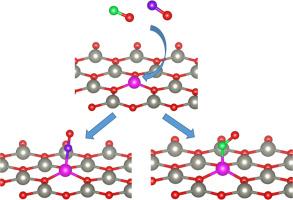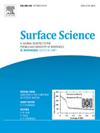掺杂过渡金属的氧化锌单层对 CO 和 NO 的吸附和传感性能:DFT 研究
IF 2.1
4区 化学
Q3 CHEMISTRY, PHYSICAL
引用次数: 0
摘要
本研究采用密度泛函理论从理论上探讨了一氧化碳和一氧化氮这两种常见有害气体在掺杂过渡金属(TM = 铁、钴、镍和铜)的氧化锌单层上的吸附行为。多方面的分析涵盖了一系列关键方面,包括吸附结构、吸附能、状态密度(DOS)和电子转移,从而揭示了吸附行为。我们的计算表明,掺杂 TM 原子的氧化锌单层具有很高的稳定性。掺杂 TM 能显著增强气体分子(CO 和 NO)与氧化锌单层之间的相互作用。对吸附体系的恢复时间和电导率的分析表明,Co-ZnO 是一种适用于 CO 传感的材料,而 Cu-ZnO 和 Ni-ZnO 则可用于 NO 传感。这些结果表明,掺杂过渡金属可以成为吸附和检测有毒气体分子的理想传感器候选材料。本文章由计算机程序翻译,如有差异,请以英文原文为准。

Adsorption and sensing performances of transition metal doped ZnO monolayer for CO and NO: A DFT study
In this study, theoretically, density functional theory was employed to explore the adsorption behavior of CO and NO prevalent hazardouss gases, on transition metal (TM = Fe, Co, Ni, and Cu) doped ZnO monolayer. The multifaceted analysis encompasses an array of critical aspects, including the adsorption structure, adsorption energy, density of states (DOS) and electron transfer to unravel the adsorption behavior. Our calculations show that TM atom doped ZnO monolayer exhibit high stability. TM doped can significantly enhance the interaction between the gas molecules (CO and NO) and the ZnO monolayer. Analysis of the recovery time and electrical conductivity of the adsorbed systems suggests that the Co-ZnO could be a suitable material for CO sensing,while the Cu-ZnO and Ni-ZnO can be used for NO sensing. These results suggest that transition metal doped can be a promising sensor candidate for toxic gas molecules adsorption and detection.
求助全文
通过发布文献求助,成功后即可免费获取论文全文。
去求助
来源期刊

Surface Science
化学-物理:凝聚态物理
CiteScore
3.30
自引率
5.30%
发文量
137
审稿时长
25 days
期刊介绍:
Surface Science is devoted to elucidating the fundamental aspects of chemistry and physics occurring at a wide range of surfaces and interfaces and to disseminating this knowledge fast. The journal welcomes a broad spectrum of topics, including but not limited to:
• model systems (e.g. in Ultra High Vacuum) under well-controlled reactive conditions
• nanoscale science and engineering, including manipulation of matter at the atomic/molecular scale and assembly phenomena
• reactivity of surfaces as related to various applied areas including heterogeneous catalysis, chemistry at electrified interfaces, and semiconductors functionalization
• phenomena at interfaces relevant to energy storage and conversion, and fuels production and utilization
• surface reactivity for environmental protection and pollution remediation
• interactions at surfaces of soft matter, including polymers and biomaterials.
Both experimental and theoretical work, including modeling, is within the scope of the journal. Work published in Surface Science reaches a wide readership, from chemistry and physics to biology and materials science and engineering, providing an excellent forum for cross-fertilization of ideas and broad dissemination of scientific discoveries.
 求助内容:
求助内容: 应助结果提醒方式:
应助结果提醒方式:


